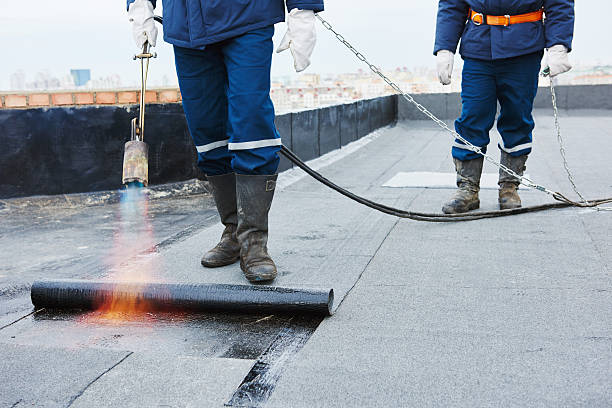Page Contents
What is roof felt and its purpose?
Roof felt, also known as roofing underlayment or tar paper, is a versatile material used in roofing systems. It typically consists of a base material (such as fiberglass or organic fibers) coated or impregnated with asphalt or bitumen. Roof felt serves multiple purposes, including:
Waterproofing: It acts as a secondary layer of protection against water infiltration, preventing moisture from reaching the roof deck and underlying structure.
Moisture control: Roof felt helps to manage and redirect moisture, preventing potential damage caused by condensation or leaks.
Enhanced durability: By providing an additional layer between the roof deck and the roofing material (such as shingles), roofing felt helps to improve the roof’s overall strength and longevity.
The cost of roof felt installation
The cost of roofing felt installation can vary depending on several factors. These factors include the size of the roof, the type and quality of the roof felt material,(like roofing felt paper) the complexity of the roof design, and the region’s labor and material costs.
Roof felt is typically sold in rolls, and the price is often calculated per square foot or per roll. The size of the roof directly impacts the quantity of roof felt required, thereby influencing the overall cost. Additionally, the chosen material and its quality affect the price. Higher-quality roof felt often comes with a higher price tag due to its enhanced durability and performance.
The complexity of the roof design can also impact the installation cost. Roofs with intricate shapes, steep slopes, or multiple levels may require more labor and time to properly install the roof felt, leading to higher installation costs.
Labor and material costs can vary depending on the region or local market conditions. It is advisable to obtain multiple quotes from reputable contractors to compare prices and ensure a fair cost for roof felt installation.
It’s worth noting that while roofing felt installation adds an expense to the overall roofing project, it is a valuable investment. The added protection and extended lifespan that roof felt provides can help prevent costly repairs and potential damage to the roof structure in the long run. Find out more on “how much to refelt a roof?”.
How does roof felt protect the roof?
Roof felt provides crucial protection to the roof in multiple ways. Primarily, it acts as an additional waterproofing layer, acting as a secondary defense against water infiltration. Even if the outer layer of roofing material, such as shingles, becomes compromised, roof felt prevents water from reaching the underlying roof deck and the structural components of the roof. By serving as a waterproof barrier, it effectively safeguards against moisture-related issues like rot, mold, and damage to the roof structure.
Additionally, roof felt helps in moisture control within the roofing system. It manages the movement of moisture vapor, allowing any condensation that forms within the roof space to escape or evaporate. This prevents moisture from accumulating and causing harm to the roof deck or insulation. By regulating moisture levels, roof felt helps maintain a stable and healthy environment within the roofing system.
What are the common causes of roof felt deterioration?
Roof felt deterioration can occur due to various factors that compromise its effectiveness over time. Understanding these common causes is essential for maintaining a durable and long-lasting roof.
One significant cause of roof felt deterioration is prolonged exposure to the elements. Continuous exposure to harsh weather conditions, such as intense sunlight, heavy rain, strong winds, and fluctuating temperatures, can gradually degrade the roof felt material. UV rays from the sun can break down the chemical composition of the felt, causing it to become brittle and lose its protective properties. Rainwater and moisture can seep into the felt, leading to rot, mold growth, and overall degradation.
Improper installation practices also contribute to roof felt deterioration. If the felt is not installed correctly, with improper overlap or inadequate fastening, it can be more susceptible to damage. Poor installation compromises its ability to provide a reliable barrier against water and external elements.
Does exposure to sunlight affect roof felt over time?
Exposure to sunlight indeed has a significant impact on roof felt over time. The ultraviolet (UV) rays emitted by the sun can gradually deteriorate the material, affecting its performance and lifespan.
When roof felt is exposed to sunlight, the UV rays penetrate the surface of the material. Over time, this exposure causes the felt to undergo a process known as photo-oxidation. During photo-oxidation, the UV rays initiate a chemical reaction within the felt, breaking down its molecular structure. This results in the degradation of the material, causing it to become brittle, cracked, and less flexible.
As the roof felt loses its flexibility, it becomes more susceptible to damage from external factors such as wind, rain, and physical impacts. Cracks and brittleness compromise its ability to provide an effective barrier against water infiltration, increasing the risk of leaks and moisture-related problems within the roofing system.
Can roof felt rot due to moisture and water damage?
Roof felt can indeed rot due to moisture and water damage. When moisture infiltrates the roofing system, it can lead to the deterioration of the felt material over time.
Moisture can enter the roof felt through various sources, such as leaks in the roofing material, poor ventilation, or condensation issues. Once the felt becomes wet, it creates an environment conducive to the growth of mold, mildew, and rot-causing organisms. This can occur particularly in areas where the moisture remains trapped or is unable to dry properly.
As the roof felt absorbs and retains moisture, the fibers of the material begin to break down. The prolonged exposure to moisture weakens the structural integrity of the felt, causing it to become soft, spongy, and discolored. The rotting process can lead to the loss of the felt’s protective properties, compromising its ability to provide a reliable barrier against water infiltration.
Is it possible to have roof felt repaired?
Yes, it is possible to repair roof felt in certain situations, depending on the extent of the damage. Roof felt repair can be a cost-effective solution that helps extend the lifespan of the roofing system.
Minor issues like small tears, punctures, or localized wear can often be successfully repaired. The first step in roof felt repair is to thoroughly clean and dry the damaged area. Once cleaned, a roofing sealant or patching material designed for roof felt can be applied to the damaged section. This effectively seals the area, restoring the integrity of the roof felt and preventing further damage.
However, it is important to note that not all damage is repairable. If the roof felt is extensively damaged, severely deteriorated, or nearing the end of its lifespan, repair may not be a viable option. In such cases, replacement of the roof felt becomes necessary to ensure the long-term performance and protection of the roofing system.
Conclusion
Roof felt plays a crucial role in protecting the roofing system by adding an extra layer of defense against water infiltration and reinforcing the roof’s durability. However, it is susceptible to deterioration, including rot, as time goes by. Several factors contribute to roof felt degradation, such as prolonged exposure to sunlight, moisture damage, extreme temperatures, and improper installation. Homeowners must remain aware of these common causes and take preventive measures to prolong the lifespan of their roof felt.
This includes regular roof inspections, immediate repairs when necessary, adequate ventilation, and the use of high-quality materials. By addressing these factors and implementing effective maintenance practices, homeowners can ensure their roof felt remains resilient and maintains the overall integrity of the roofing system. By understanding the risks associated with roof felt deterioration and taking proactive steps, homeowners can safeguard their investment and enjoy a durable and long-lasting roof for many years to come.

Lois Lane is a professional blogger and a seasoned Content writer for wellhousekeeping.com. With a passion for simplifying complex Home Decor topics, he provides valuable insights to a diverse online audience. With four years of experience, Lois has polished his skills as a professional blogger.




